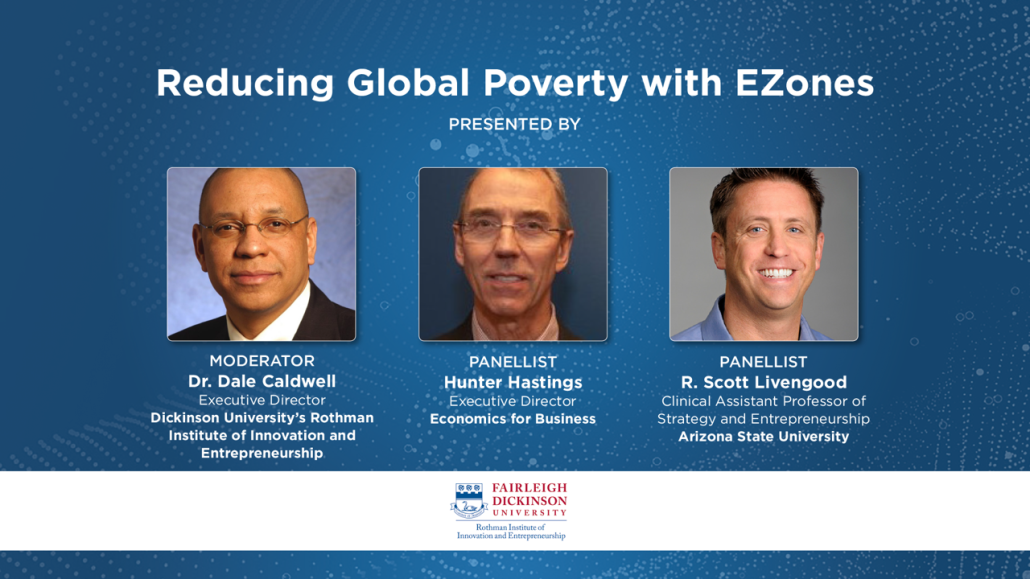Four Simple Rules For Initiating Entrepreneur Zones Anywhere In The World.
Entrepreneur Zones or EZones are place-based accelerators located in economically challenged communities that result in a sustainable ecosystem creating local living wage jobs. The concept was originated by Dr. Dale G. Caldwell, the Executive Director of Fairleigh Dickinson University’s Rothman Institute Of Innovation And Entrepreneurship.
An EZone is a collaboratory that provides guidance, training and financial support to companies within a specified geographic area. Coopetition, a form of mutuality where the businesses work together while competing for clients, is the key to ensuring that the businesses have the necessary support and skills. The goal is for these businesses to become profitable enough to generate as many jobs as possible in the local community.

Solutions through Inclusivity Virtual Summit on November 17th, 2021
_____________________________________________________________________________________________________________________________________________________
The science of systems-building has evolved significantly over recent decades. While recognizing that economic ecosystems emerge and grow as a result of a vast number of ongoing interactions between people, firms, neighborhoods, markets, supply chains, prices, jobs, education, health and many more, it is nevertheless possible to identify the web of causes that result in sustainability and economic thriving. Causality can be linked to a simple set of rules that everyone in the system knows and can follow; the rules become a culture and the culture nurtures successful outcomes.
The four simple rules for EZones are:
1) Through empathy, identify a desired valuable experience.
Entrepreneurs generate value for others – their customers. Value is a tricky thing to identify – it’s entirely in the mind of the customer, subjective and idiosyncratic and often changeable. EZone entrepreneurs actually enjoy a potential advantage. They live in the local community and are close to their neighbors and friends and have a better idea of the dissatisfactions people want to address. Maybe an entrepreneur knows that a mom in town would like to work at a paying job if only she could get help with cooking and laundry and babysitting or in-home teaching. Maybe the entrepreneur knows that the local quarry owner needs a special kind of driver for the under-maintained trucks that are finicky and unpredictable in their performance. Maybe the entrepreneur is aware of some artisinal craftsmanship that could find a market on Etsy. Empathy is the skill to identify others’ desires and dissatisfactions. Everyone is capable of empathy; the skill can easily be honed to apply in economic situations.
2) Translate empathy into a deliverable service.
There’s a gap between understanding another’s needs and successfully offering a solution that results in a transaction and a sale. The articulated (or unarticulated) need is never identified with perfect precision and the product or service that’s designed to meet it is never 100% accurately targeted. That’s OK. It’s normal. The task is to make the design deliverable. Can the entrepreneur bring the finished product or service to the customer in such a way that the customer can buy and the exchange can be made? Can the proposed in-home cooking and cleaning service recruit the right people that the customer will trust, train them and place them in the customer’s house on the right day for the right number of hours to perform the service in way the customer wants. This process is capacity building. How is the entrepreneur going to get the job done? What people are needed? What tools will they need? Will they be well-aligned with the mission of serving the customer? Capacity is the state of readiness.
3. Remove all barriers.
Even when capacity is built and aligned, there will be barriers to completing a market transaction – mostly in the mind of the customer. Is the price right? Are there alternatives i don’t know about or have not fully evaluated? Can I trust the entrepreneur to keep the promises made? Am I really ready to take this leap? The entrepreneur must be able to sense all these barriers (often unspoken) and maintain the energy to remove them as they arise. This phase of entrepreneurship has been likened to sharpening a pencil – the art of removing and removing until the point is as sharp as desired and ready to use for the purpose it was designed. Entrepreneurs are constantly sharpening.
4. Set up feedback loops.
Ecosystems grow and thrive as a consequence of their feedback loops. Feedback loops are a form of closeness to the customer – setting up mechanisms for monitoring, listening, data collection and adaptive response. It’s another aspect where EZone entrepreneurs are advantaged: they are in the community, naturally close to their customers both physically and emotionally, and open for communication. As they expand their markets beyond the community, including via the internet and e-commerce, they extend this natural advantage into better customer listening and customer service that will serve them well as their businesses grow.
These four simple rules – empathy, capacity, no-barriers and feedback – will guide EZone entrepreneurs in a system of networked value co-creation with customers that can scale to any level once it gets started.
How does it get started? There are 4 simple steps to energize the 4 simple rules.
Convene the network.
The “Big Bang” for the EZone ecosystem is the first convening. There are existing businesses and business owners in the EZone geography, and there are aspiring entrepreneurs who haven’t yet got started. There are community supporters who want to help – whether these be churches or associations or clubs or business roundtables. There are educational institutions, whether these be schools or colleges or universities. There may be some large firms (banks, for instance) who would like to support EZone growth. There might be non-profits and philanthropic organizations to help. There is technical infrastructure to be tapped. There may even be government support, although EZones don’t expect it and don’t want to be restricted by bureaucratic rules and impediments.
Physically bringing together all these groups to talk and begin thinking about a shared vision and mission is both necessary and sufficient to impart initial momentum to the EZone. Energy builds from this start.
Value Co-Creation Training.
Entrepreneurship is a learnable process. Professor Scott Livengood has designed a training curriculum specifically for EZones and their participants. It starts with developng the appropriate mindset, emphasizing that entrepreneurship is subjective and that the right mindset is the precursor to sound entrepreneurial judgment. The training is fun and engaging, encouraging and empowering. it imparts knowledge, skills and process and introduces tools for participants to use with immediate effect. Most importantly, it can imbue with confidence even those who are uncertain.
Let the exchange begin.
The secret to getting started is to get started. Entrepreneurship is exchange. The first exchange tumbles the dominoes. EZone training and infrastructure are in place to help entrepreneurs get everything ready to go, whether that is setting up digital or physical storefronts, initiating manufacturing, assembling supply chains, connecting to business partners, or developing sales and marketing campaigns. The checklist may be long but it is do-able. Entrepreneurs simply need the momentum to get up to – and one step beyond – the start line.
Explore and expand.
Once under way, the entrepreneurial process is relatively simple: continuously explore different elements and components of the value proposition, evaluate the customer acceptance via feedback loops, and do more of what works and none of what doesn’t. The explore and expand mechanism is a flywheel – it keeps on turning and growing and strengthening. Entrepreneurs quickly get to the point where momentum can take over and management and growth replace experimentation – but the EZone entrepreneur never stops exploring.
4 simple rules and 4 simple steps are sufficient for EZone acceleration from inception to expansion to sustainability.







Leave a Reply
Want to join the discussion?Feel free to contribute!